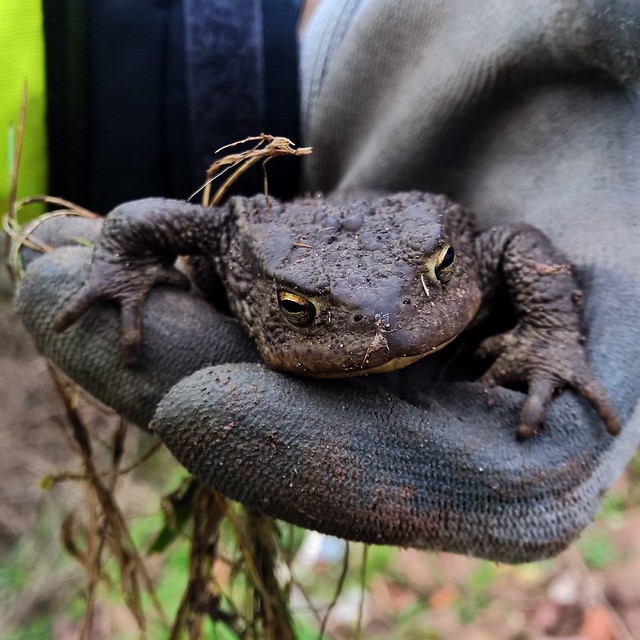My first newt season to be precise. I’d been looking forward to it…
I had completed the Cheshire Active Naturalists (CAN) course the previous year which taught me Great Crested Newt (GCN) surveying and ID skills (which included ID training in all British amphibian species), and counts as one of the two references I would need in order to apply for a GCN surveying licence one day. But I hadn’t managed to get involved with any newt work before the season ended and my work placement year at an ecological consultancy began in July. I knew there would be newt work come the new season. There’s always lots of newt work said the ecologists.
Newt work has an element of mystery to it. It’s like the breakfast cereal in the advert that the dad tells his kid they wouldn’t like. Ask a newt worker what newt work is like and they’ll tell you the hours are antisocial and the ponds are smelly. There often aren’t any newts at all and you get bitten by mosquitoes they say. And the terrain is annoying to walk on, and you might fall in a pond and…oh and weil’s disease! You might get weil’s disease which in the most severe cases includes symptoms of nausea, vomiting, inability to control physical movements and uncharacteristic violent behavior. Newt work can literally turn you into a vomiting zombie bog creature.
So as I say I’d been looking forward to my first newt season because newts are cool and the worse you tell me something is the more curious I get about trying it. There are two types of people in this world. Ones to who if you say “Try this it’s disgusting” will try it and ones who wont.

When you actually go out and do newt work you discover that there are pleasures to it which compensate for all of the above and that those same newt workers who extolled its negatives actually rather like it while they’re doing it. I got my first taste of this on a job in Cheshire where Tom, Damien and I assisted Rebecca in several visits to a scrubby area of woodland behind an industrial site which contained a big pond and several little ponds. Our job was to establish population size using terrestrial (checking carpet tiles previously laid out by Victoria and myself on a another visit), bottle (setting bottle traps late afternoon and checking them early the following morning) and torch (surveying the water by powerful torch light after dark) survey techniques.
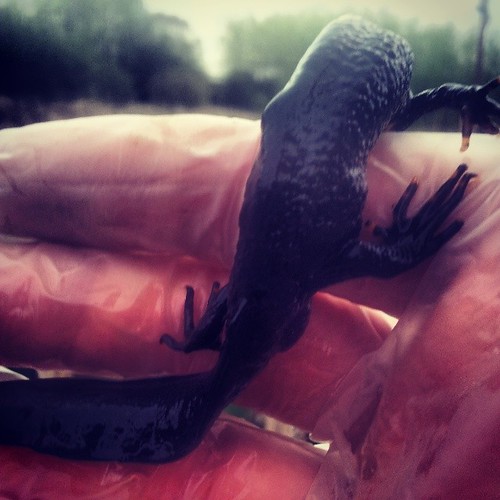
Wearing waders – Waders are like having a key to a secret garden. I wish I’d had a pair as a kid. So many times while exploring in the holidays my friends and I would come across a random water body full of who knows what but unable to explore it in our trainers we’d sit on the jetty and just look out (probably for the best).
Waders bring with them a set of challenges however. A leaky wader is as distracting as a mosquito in the ear. The water pressure might mean the wader doesn’t leak until you move into shallower water then it leaks a lot and you try to hurry to a level where the hole or tear is out of the water. Hurrying in a pond is living dangerously. When you wear waders a lot you get used to them and if you suddenly switch back to wellies you might go marching into a pond up to the knee without thinking about it.

On my first visit to the Cheshire site I discovered the weird world of pond legs. You tentatively try the submerged and obscured ground beneath the water in front of you one foot at a time, like an animal learning to walk. Your arms stick out reflexively in different directions for balance. As you move around your confidence increases and you move faster but then your back foot gets a little stuck causing you to lose balance and your legs suddenly cross themselves in a way that might help, on land. Pond work means you experience that strange other side of yourself that takes over control of your body when you stumble and keeps you upright with a flurry of jerky movements and “wuoOo-uh!” sounds regularly. Most times it works a treat and I’m often reminded of when a flight attendant told me that plains “want to stay in the air”.
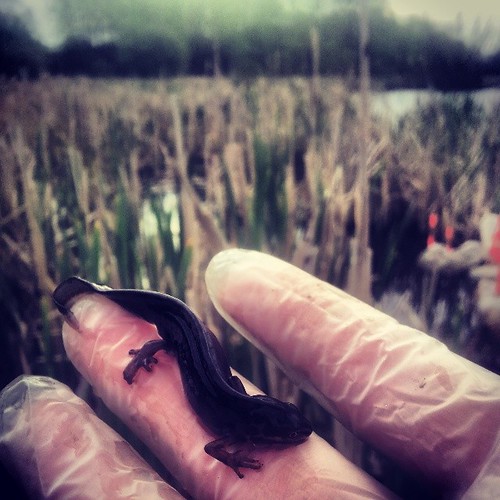
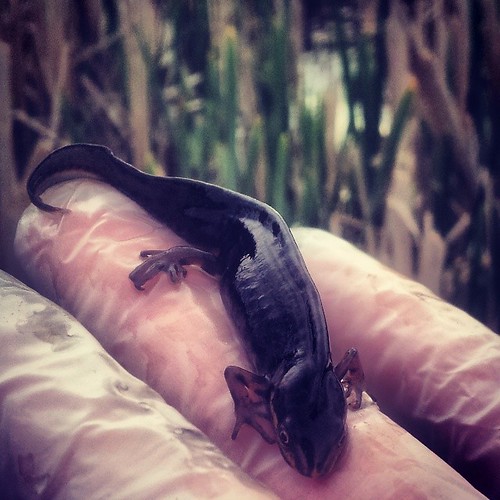
I also discovered the perils of the false floor. You put your foot on it and press down. Feels like the floor so you put your whole weight on it and it suddenly drops, submerging your leg to above the rim of your wader. Water floods in as you sluggishly heave the now very heavy leg out of the pond. I called over to Rebecca and Damien before emptying a pint of pond out of my wader. May as well share the moment I thought. That was unfortunately only 15 minutes into the first pond so I had a wet leg, foot and sock not only for the survey but also during dinner in a local pub. When a member of the public observed me attempting to dry my trouser leg with the wall mounted hand dryer in the toilets I didn’t even bother trying to explain what I was doing.
The traps – Bottle traps if you don’t know are made from clear 2 liter plastic bottles which have been modified so that when a newt gets in it can’t get out. This is less to do with the complexity of the trap and more to do with a newt’s inclination to search for an exit around the side of the trap rather than in the middle. The skill with trapping, which necessitates training and support, is setting the trap such that it contains enough air for the newt to survive. Trap design varies so different techniques may be needed for different traps but for all of them, no air at all and the newt will not last the night and you do not want to find a dead newt in your trap.
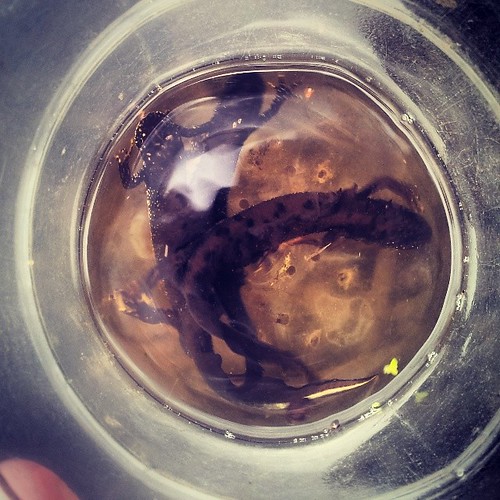
(these are alive by the way)
Another skill to learn is to carry many traps at once. Too few and you have to make repeat journeys to your kit pile. Two many and you become clumsy. I could be imagining it but I’m sure I have stronger fingers now than I did at the beginning of the season. Newt workers hands. I imagine I’d be good at rock climbing now.

Most important when it comes to traps is your ability to remember where you set them and find them the next day. This doesn’t sound like it should be difficult and with a few simple techniques it is always possible but when you’re setting traps in water deep enough that only a foot or so of your cane is exposed and there are horsetails and various other vegetation obscuring your view you encounter a variety of problems. For example what you could see from a certain angle the night before may be invisible from the slightly different angle the next day. For this and other reasons I have learned that it is not unusual to collect your traps in, count them, and discover you are one short. With so many other variables to consider from balance to wildfowl it is inevitable and that’s why you keep good notes as to how many you have put in, and count carefully how many you have taken out. If you come up short, you retrace your steps and find the one you have left behind.
You never leave without bringing all your traps in. The traps are simple in design but they work. If a newt gets in, it can’t get out. And once in, it attracts other newts, especially if it’s female. That’s why one trap may have none in, and the next, 2 meters away might have 10 in. If you leave the trap in the pond the newts will keep coming and they’ll all die in there. Being too proud to admit you’ve lost a trap would be a very bad quality in a newt worker. If the trap is there, it can be found, you just have to keep looking.
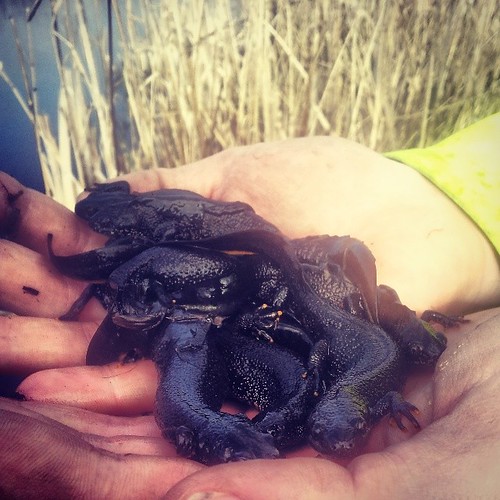
The other pond life – One of the things I like most about consultancy work is that as well as the species you are there to study you invariably see a host of other creatures too. On bat surveys you see foxes and hedgehogs, on badger surveys you see birds deer.
On newt surveys you see frogs and toads. Frogs are fun, you find them in the traps sometimes. They must have invested some effort to squeeze themselves into the trap only to find themselves stuck. Upon releasing them you have little chance of getting them in the hand, they hop skillfully through your fingers and into the pond where they plop and vanish. Toads I like even more. Their tactic is just to sit in your hand and wait until you get bored and do the plopping for them. Both species go about their business in the ponds as though you aren’t there, or they don’t care that you’re there. As you scan your torch across the surface you sometimes see a toad lounging casually half out of the water on a floating reed stem.
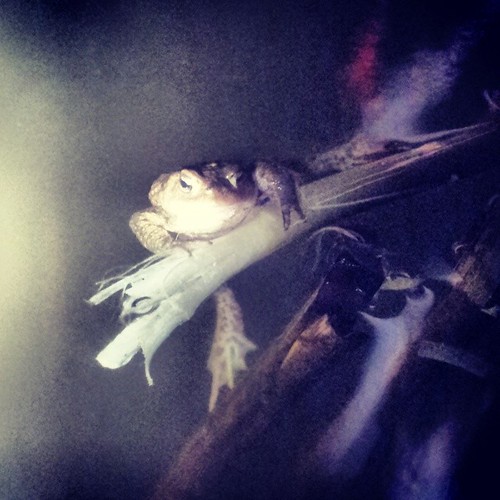
Then there are the diving beetles. Emerald giants the size of an old 50p but a smooth lozenge shape paddle around the vegetation or rattle in your trap as you empty it. And the larvae, nightmarish mini monsters, one day to be dragons thrash in the traps. They make me think of that old TV show Land of Giants where people find themselves the size of a key ring and spend an entire episode trying to get away from a cat or off a kitchen table. Dragon fly larvae would have made a great beast if they’d ever found themselves adrift on a pond.
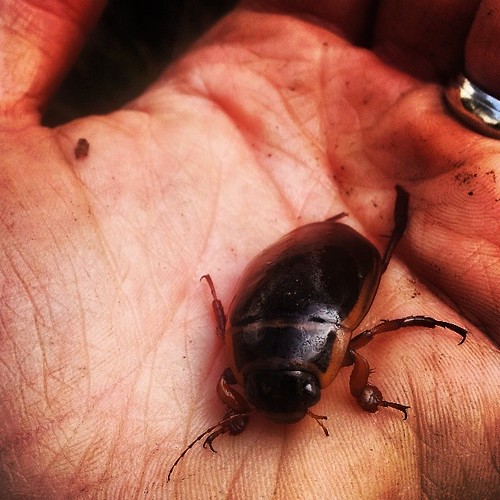
The peace and quiet – When the traps are in and you’re back doing your torch survey, the sun has gone down and there’s just you slushing carefully through the reeds towards the open water, or along the bank. Maybe it’s spotting with rain but you’ve got waterproofs on and your hood up, torch in hand. The occasional rusting of a coot and the sound of you in the water and your colleagues near by. Your own torch lighting up the water in front of you and one or two others in the distance around the pond. Peace and quiet. Even after a hard, long afternoon of setting traps out, people don’t mind heading back out into the field in the dark because it’s one of the most enjoyable parts of the work.
The newts -My first proper newt survey began with frogs and toads as we set out the traps. If the water is clear you see them sat on the floor of the pond, minding their own business. The cloud of silt stirred by your feet washes over them like a macabre aquatic dust cloud, like those created by a fallen building. They don’t move so you must remember where they were and avoid the spot with your feet as you move on.
It was later on the torch survey that I saw the newts, my first glimpse since the CAN course a year prior. The flash of a tail in your peripheral vision like a waved ribbon disappears into the silt as your eyes snap over to it. Another just missed flurry of action and another…then your eyes scan over a shape on the floor and something in your brain sends them back for a second look. Amid the many slender willow leaves, dark and decomposing on the pond floor is a willow leaf with legs. On closer inspection it’s no leaf, and has a rounded head at one end. You shine your torch on it and it remains dead still. You waggle your torch beam back and forth over it and tickle the beast into action, an energy packed split second sends it off like a kite tail in a gale, off into the silt or vegetation. You make a mental note.
If there are many newts on your torch survey you might keep a check score on a note pad of species and gender, or if you have a good memory you might keep track in your head. Someone recently told me their trick for keeping track of having female and males either side of a decimal point. So 24 female GCN, 5 male GCN, 14 female smooth and 19 male smooth would be 24.5, 14.19.
The next morning I discovered the pleasure of checking your traps. Finding newts in the trap you’ve set is good for two reasons: you know you did a good job setting it; and you get to see a newt close up. Newts are awesome! They’re exotic looking and they don’t try very hard to get away from you until you put them back into the water. If you have one in your hand you can look right into their eyes and wonder what on earth you look like to them. Then they clamber over your fingers like a monster in one of those old movies where they filmed tortoises close up to make them look giant.

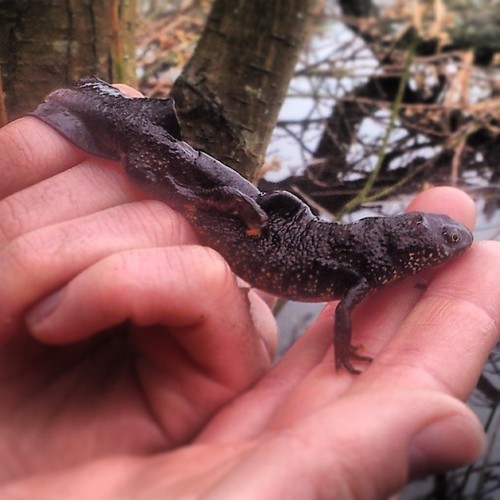
Newts are like watching Malcolm in the Middle. My favourite changes depending on who I’m looking at. A big male GCN in the water with their crest visible, a big female GCN in the hand, a female smooth creeping through the vegetation or a male smooth close up, they’re all such impressive beasts and after seeing hundreds this season I’m not bored yet. I’ve been lucky enough to be part of several newt projects, some with more newts than others. It’s great when there’re lots, but when there are few you get even more excited finding the odd one in a trap after several ponds or traps with none.
I’ve put in for my licence now so will hopefully soon be a licenced newt worker. I’ve loved my first newt season and look forward to doing it all again next year. With the new eDNA technique being trialled this year it’ll be interesting to see how newt work evolves. I was lucky enough to get to try the sampling process recently. I’ve heard some say that this will be the last newt season as we know it. It certainly has the potential to change the industry but I suspect there will still be need for newt workers to trek through long grass with arm fulls of canes and traps for some time yet.
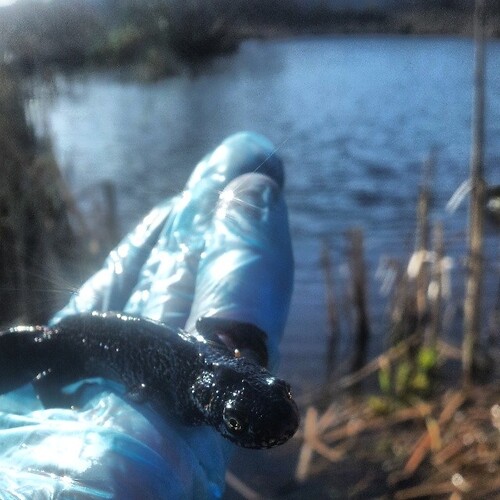
I was on a bat survey with Helen the other day. We were walking though a field in Staffordshire on a transect survey when Helen suddenly exclaimed: “Hello! What are you doing here!”. There was a large, female GCN romping through the grass in front of us.

